Visits: 2
Apple’s macOS Catalina has arrived, and you can install it on your Mac right now, provided your device is new enough to actually install it. We’re going to dive into macOS Catalina, all of its features and how to download it, but first a little bit of history.
Apple first revealed macOS Catalina at its WWDC 2019 conference in San Jose, California earlier this year, during which the company showcased some of the awesome new features that macOS Catalina brings to the table, including its nifty capability to use an iPad as a secondary screen.
So, after a wait that seemed to take forever, we can finally download the update. This is a massive update, too, as through a new feature called “Project Catalyst,” iOS 13 and iPadOS developers can easily port their work over to the macOS environment. This means if you update your Mac today – though, you may want to wait – you should have access to a lot more Mac apps.
There are a few things going away though. For instance, iTunes, the media software that’s been a mainstay for almost two decades, has gone into that long night. In its place, however, we get a new Mac-flavored Apple Music app, along with Apple Podcasts and Apple TV. So, don’t be concerned, you can still listen to your music and watch the new season of The Good Place.
All of this is just the tip of the iceberg for macOS Catalina. Don’t worry though, we’re going to dig into everything that macOS 10.15 has to offer, from the features to which Macs are able to actually download it. And, be sure to keep this page bookmarked, as we’ll keep it updated with all the latest macOS 10.15 Catalina news as they pop up.
If you’re having issues, check out our macOS Catalina problems: how to fix the most common issues guide for help.
Cut to the chase
- What is it? macOS 10.15 Catalina, successor to macOS 10.14 Mojave
- When is it out? Out now
- How much will it cost? Nothing. Apple software updates are always free

The macos 10.15 features Sidecar so you can use your iPad as a secondary screen.
(Image credit: Apple)
macOS Catalina release date
Apple held its iPhone 11 event on September 10, but the show came and went without so much of a mention of macOS 10.15. Still, Apple’s macOS 10.15 Catalina page was updated with an “October 2019” release window. Apple didn’t share any more specifics about the release, so when it launched it caught us all by surprise.
Fortunately, this does mean you can now download macOS Catalina, so long as you have a compatible Mac. You might want to wait until the next update comes out, just to ensure that any serious bugs are squashed. You see, updating your operating system is definitely a large undertaking, and you could possibly break something, losing a lot of valuable data. So, if you don’t absolutely need the new software, waiting may be your best bet.
We’ll update this hub as soon as we know a new update is on its way, but if you want to live on the edge, go ahead and hit that download button. We’ll show you how.
macOS Catalina compatibility
If you want to get your paws on the latest macOS update, you’ll have to make sure your Mac can really support it. Fortunately, if you already have macOS Mojave installed, you’re probably in the clear. Unless, of course, you circumnavigated Apple’s restrictions.
- 12-inch MacBook (2015 and later)
- MacBook Air (2012 and later)
- MacBook Pro (2012 and later)
- Mac mini (2012 and later)
- iMac (2012 and later)
- iMac Pro (2017)
- Mac Pro (2013 and later)

What Apple Music will look like.
(Image credit: Apple)
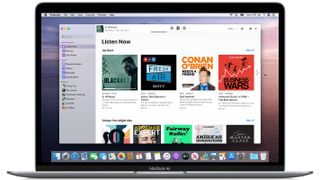
What Apple Podcasts will look like.
(Image credit: Apple)
Goodbye, iTunes – hello, Apple Music, Podcasts Books and TV
It’s official, iTunes is no more. From its ashes, however, rises a unique collection of magnificent apps for macOS: Apple Music, Apple TV, Apple Podcasts and Apple Books – and they will be polished versions of those already found on iOS.
Apple Music gives macOS Catalina users access to their entire music libraries regardless of whether the tracks have been downloaded or are being streamed. This also holds music that’s been ripped from CDs, incorporated into the same libraries.
Apple TV, on the other hand, is home for the app’s channels and offers more than 100,000 iTunes movies and TV shows that you can browse to buy or rent. And, content will be available in 4K HDR video and Dolby Atmos audio wherever it’s offered. Apple TV+ can also be accessed courtesy of this app now that the service has rolled out.
At the same time, Apple Podcasts brings the service’s more than 700,000 podcasts, as well as new episode updates, to the Mac in a totally fresh interface. This rendition of the app also offers better search functions that can pull up episodes by hosts, guests or even discussion topics.
Finally, Apple Books is the portal to all the audiobooks you would want to purchase, download and listen to. Similar to the other new apps, it also features a familiar interface for anyone who is used to iTunes.
Concerned about all your existing music and playlists, as well as iTunes gift cards and credit? Don’t worry. All your music and playlists will be transferred over to the Apple Music app in macOS Catalina. Plus, any iTunes gift cards or unspent iTunes credits are still valid to be used in these new apps.
In macOS 10.15 Catalina, the iTunes Store, which is accessible through the Sidebar in the Apple Music app, is still available to buy new music. And of course, you can also subscribe to the Apple Music streaming service using the app – if you do, you can hide the iTunes Store for a cleaner, more minimalist interface.
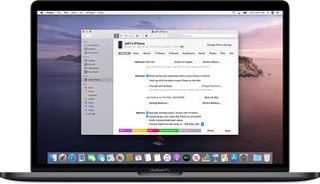
You’ll sync your devices via Finder in macOS Catalina.
(Image credit: Apple)
With iTunes making its exit, syncing devices in macOS Catalina is now taken care of courtesy the Finder app. It can back up and sync those devices. According to Apple, it will be easier to drag and drop files for quick transfers as well.
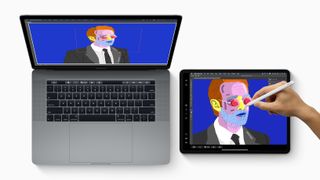
Apple Sidecar at work in macOS Catalina.
(Image credit: Apple)
Sidecar turns your iPad into another display
This is perhaps the most thrilling update that macOS 10.15 Catalina offers: the ability to extend your Mac’s display to a nearby iPad, whether wired or wirelessly. A good amount of MacBook users are already own an iPad, so this essentially means that a significant number of mobile workers just received a secondary display for free.
Possibly even more notable for designers is that this connected iPad can also be used as a drawing tablet with specific supported apps. Final Cut Pro X, Adobe Illustrator and iWork are the first apps listed that support this capability.
The Sidecar feature is supported by those models that can also run the new iPadOS, specifically the iPad Pro (all models), iPad (6th generation or later), iPad Mini (3rd generation or later), and the iPad Air (3rd generation).
Apple says that the following Mac apps will support Sidecar’s Apple Pencil input and other enhanced features:
- Adobe: After Effects, Illustrator, Premiere Pro
- Affinity Designer & Affinity Photo
- Cinema 4D
- CorelDRAW
- DaVinci Resolve
- Final Cut Pro & Motion
- Maya
- Painter
- Principle
- Sketch
- Substance Designer & Painter
- ZBrush

Screen Time for macOS has a special “One more minute” feature.
(Image credit: Apple)
Screen Time comes to macOS
One of Apple’s most meaningful changes to iOS 12 was Screen Time, an app that tracks your iPhone or iPad usage time and offers insights into the trends. This time around, this feature will not only come to macOS with Catalina, but also offer a new “One more minute” feature, giving you more time to save your work or finish up a game.
This information will also be synced across your other Apple devices, so that you have a complete profile of how often you look at your collective screens, as well as get tips on what to do with that information. Additionally, it will also include parental controls on time spent using a Mac, as well as with whom kids are able to interact with on those devices.

Twitter’s return to macOS was made possible by Project Catalyst.
(Image credit: Apple)
Project Catalyst
Thanks to Apple’s new Project Catalyst initiative, macOS 10.15 Catalina will soon be populated with a slew of iOS and iPadOS apps. There are a number of them available at launch, but the real potential of this initiative is that it opens up the floodgates for all kinds of apps to come over to the Mac.
For developers, it all seems to start with simply checking off a box within the Xcode app in macOS 10.15 Catalina. A series of new features and protocols then become available to the app in the development phase, from which the developer can choose to add to their apps – presumably with additional yet lighter coding.
It looks to make the process smoother and even quicker, with even the likes of Twitter using the tool to more effortlessly bring its native app back to macOS from iOS.
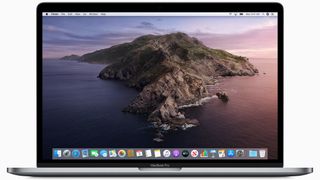
A new desktop theme for macOS Catalina.
(Image credit: Apple)
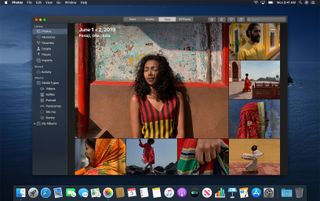
The new Photos app organization features for macOS Catalina.
(Image credit: Apple)

The new Safari launch page in macOS Catalina.
(Image credit: Apple)

Notes has a whole new look and feel in macOS Catalina.
(Image credit: Apple)
Other fun improvements
Safari browser now has a new startup page that uses Siri Suggestions to surface commonly visited websites, bookmarks, iCloud tabs and more.
Mail now lets users block messages from senders, mute message threads from issuing push notifications and send unsubscribe requests from within the app to mailing list providers.
Lastly, Reminders gets an overhaul in the visual interface so that it will allow users to more easily create, keep track and organize their reminders.
